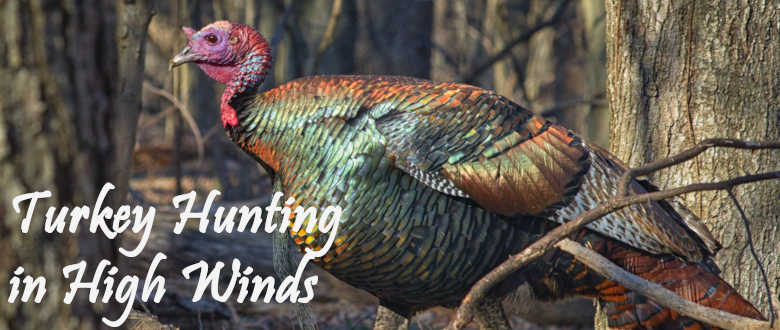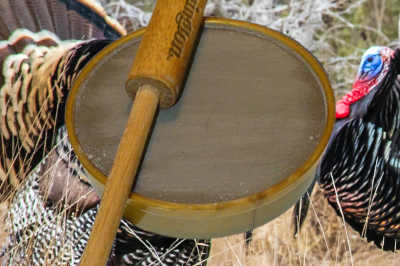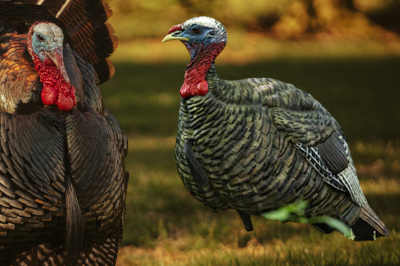Hunting turkeys in high winds is challenging due to weather conditions that are out of your control. But windy days can be successful if the right factors are taken into consideration.
The best windy day strategies:
- Use a tight choke tube
- Cover more ground
- Rigid decoys work best
- Call from upwind
- Target draws and swales
- Use high density ammo
- Hunt closer to the roost
In this guide we will discuss the biggest hurdles that arise from hunting turkeys on windy days in more detail and how to use them to your favor. Windy day hunting can even be better than calm days once these 7 tips are mastered.
And if you want to see the leading choke tubes for turkey hunting, be sure to check out the Carlson’s Long Beard XR Choke and the TruGlo Head Banger Choke.

7 tips for hunting turkeys in high winds
Just because the winds are howling from the south as winter turns to spring, doesn’t mean you can’t be successful while turkey hunting. Learning to use the wind to your advantage can mean that tricky old gobbler that never seems to come within range is now in your sights.
In high winds, always cover more ground, use rigid decoys, call from upwind, target cover and draws, and to use high-density long-range ammo. The time to implement these tactics is when the wind exceeds 30 mph.
1) Use a tight choke tube
Turkey hunting on windy days usually means that the birds will not work within the close ranges you may be accustomed to. Whether it’s the rustling vegetation or movement caused by the wind, turkeys approaching a decoy setup can be very weary.
This can result in longer shots past 50 yards where a tighter choke tube is needed. Typical turkey chokes in 12-gauge hover around a diameter of 0.665” which is even tighter than a full choke. Keeping a tight pattern keeps the pellets together longer and reduces wind drift that occurs when the shot column opens up.
So, on windy days, switch your choke to .665” or tighter since the likelihood of close in shots is low. If birds hang up and won’t commit fully, you’ll have the perfect setup to reach out and touch them. For our picks of the best turkey chokes that deliver tight patterns in a 10-inch circle, check out the guide here.
2) Cover more ground
Turkey hunting during a stiff breeze can make hearing and seeing gobblers difficult. When the wind gets past 30 mph, turkeys tend to seek shelter and hunker down. This means they aren’t moving as much, so you may just have to go to them.

Covering more ground is the best approach since it involves taking the hunt to the birds and outsmarting them in a non-traditional way. First, identify the areas the birds are most likely to use a refuge, and then develop a of attack that takes into consideration wind direction and their line of sight.
Approaching from downwind means turkeys won’t be able to see you, and if done later in the evening, you can even use the sun to mask your silhouette. The most successful turkey hunters on windy days tends to be those that cover the most ground.
Related Products
3) Rigid decoys work best
A stiff wind can damage fragile turkey decoys, so switching to a rigid decoy design is the first step. Ditch the lifelike mounts and real feather fan tails on days where the wind is howling. Not only does it not look realistic as it flops in the wind, but it could also damage your turkey mount for good.
Lightweight decoys, like those made from collapsible foam, can work on windy days, but are often thrashed around by the stiffest of winds. Inserting the stake all the way into the ground can give it more stability, but they often lack the structural integrity needed that rigid decoys happen to offer.

The Flambeau King Strutter is one rigid decoy that happens to work well in high winds. The molded design won’t collapse and paired with a synthetic fantail, won’t look unnatural in a 30-mph wind. It can even pivot on the stake as the wind direction changes. Stick to rigid decoys on windy days and your success rate will likely increase.
4) Call from upwind
Gale force winds are the enemy of most turkey hunters, but even in the worst conditions a plan can be made to make the most of it. The bight side is your calling will travel further on windy days and using that to your advantage can mean birds that may have not heard you otherwise, can now be coxed closer.
High vantage points and open fields work best for this method since the sound travels further. Let the yelps travel with the wind and look for any movement of birds responding. You won’t be able to hear them gobble back, but a good pair of binoculars or a spotting scope can give you the advanced notice to get ready.
Slate calls work extremely well on windy days due to the amount of noise they can create. Diaphragm turkey calls also travel long distances. Box calls are better left for sealing the deal for close in birds that require subtle reassurance.
5) Target draws and swales
Protection from the wind is at the top of a turkey’s mind on the windiest days. Most wildlife prefer to hunker down in these conditions, and turkeys are no different. Keying in on draws and swales should be top priority once the wind climbs above 30-mph.

Fence lines, vegetated rows, scrub-shrub thickets, and subtle elevation rises provide the cover that turkeys seek to get of the wind. Identifying the most likely areas of cover upwind from the roost is typically the best strategy for locating turkeys that aren’t moving much on windy days.
Thick vegetation near water sources also provides a good hide out for turkeys seeking calmer areas. Develop a game plan on windy days to get close to areas like these that turkeys are likely using and draw them out. Being mobile and covering the most ground are keys to being successful on windy days.
6) Use High density ammo
Turkey hunting in high winds can wreak havoc on ammo ballistics and the largest is wind drift. Crosswinds tend to be the worst and for longer shots, this effect can cause the shot column to travel off target by inches or even feet.
One of the best ways to reduce these effects on windy days is to use tungsten or other high-density ammo. Heavier pellets, like those in TSS or Heavyweight loads, keep their mark better than lighter pellets. Heavier alloys require more force to move offline and thus aren’t bothered by higher wind scenarios.

Paired with a full or turkey choke, TSS ammo can be effective at over 70 yards. This essentially opens up hunting scenarios that wouldn’t otherwise be possible. Decoying turkeys is almost always about getting them in close, but on windy days that’s not always possible. Use high density ammo if your hunt depends on it. And if you reload, here’s your options for bulk TSS shot.
7) Hunt closer to the roost
Wind direction plays a big part in deciding where to set up, but so does wind speed. Ambushing turkeys as they leave the roost has always been a preferred tactic, but on windy days it can require being even closer to their favorite roosting spots.
Turkeys prefer to roost in large, open trees like Cottonwoods. It allows them to perch up high at night and avoid predators down below. Early in the morning they fly down and gradually work their way outward to feed, get water, or find suitable mates.
On particularly high wind days, setting up in the dark about 100 yards or less from the roost can mean you’ll be in the right spot once daylight arrives. Rather than hope they will cover more ground later in the day, don’t expect them to if the wind is really howling.
![]()
Bottom Line
Hunting turkeys in high winds can be challenging if you don’t know the right tactics to use. They often don’t travel very far and the slightest thing being off could send them scurrying away. Here are the 7 strategies to implement on your next turkey hunt:
- Use a tight choke tube
- Cover more ground
- Rigid decoys work best
- Call from upwind
- Target draws and swales
- Use high density ammo
- Hunt closer to the roost
These tactics are designed to help be more effective on windy days where turkeys may not travel much and shots on them can exceed 50 yards. As always, scouting the local flock and determining their routine will help put you in the right place at the right time on windy days.
If you’re wondering which chokes you should get for turkey hunting, there’s no better place to start than our lists of the best turkey chokes. Whichever choke you pick, just make sure it fits the choke system on your shotgun.
Was this helpful?
Search Chokes by Gauge
Latest Posts
- Best Waterfowl Choke Tubes for 2024, Expert Picks
- Choke Tube Diameter and Constriction Table
- 5 Easy Ways to Remove a Stuck Choke Tube
Last update on 2025-12-03 / Affiliate links / Product Images from Amazon Product Advertising API






